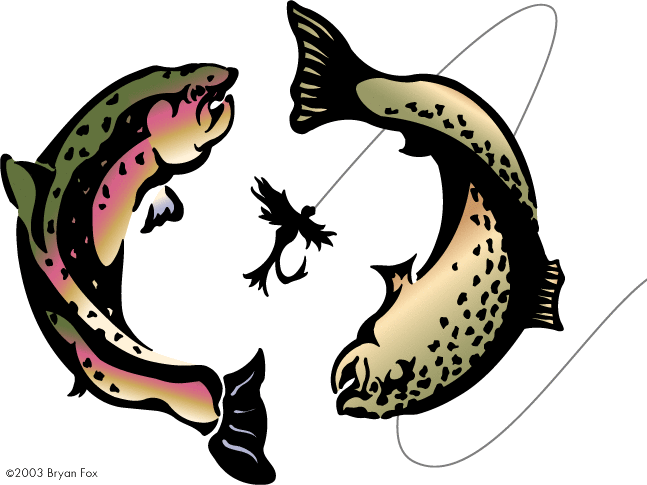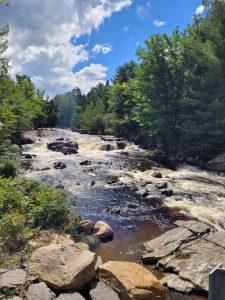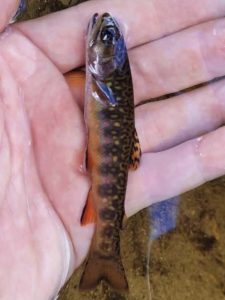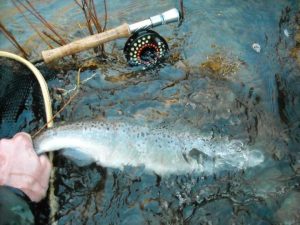The Finger Lakes are a truly beautiful place to live and to enjoy fly-fishing. The area is blessed with many majestic waterfalls, gorges and interesting rock formations and is also graced with a variety of migratory fish which enter the tributaries at various times of the year. The diversity of tributaries in the Finger Lakes, each having unique beauty and many having a scenic waterfall a short distance from the lakes they feed, gives the fly fishing angler many choices for a day of fly fishing.
One late fall day back in December of 2000 I made the decision to fish one of my favorites tributaries which was a short drive from my home. At the time I was experimenting with different streamer patterns that are intended to mimic small baitfish and had designed a few that had produced a fish or two. While fishing the colder water of late fall I would usually put a bb sized split shot or two on the leader a few feet above the fly or use a sinking leader to help the fly sink. I was also experimenting with sinking leaders which I created from a full sinking line I had bought for lake fishing. I cut the sinking line into different length pieces and put some braided loops on each end creating a variety of weighted sinking leaders. As with most fly anglers, I thought that I needed to get the fly down by using some weight to get the attention of a fish. On this trip, for some reason, I decided to fish a weight forward floating line and a monofilament leader without any added weight or sink tip. Something told me to abandon the weight and see what happens.

This particular day was a fairly cold day with air temperatures around freezing. As always when fishing for migratory fish, I imagine I was hoping, what every fly angler hopes, that there were some fish in the stream and they were in a biting mood. I parked in the small dirt parking lot on the south side of the stream and walked the short rocky trail which meanders just behind a large pipe that must have been part of the local water system at some point. Its always good to approach the stream and see a limited number of anglers, and on this day I was lucky to find I was the only one fishing the entire area possibly meaning any fish in the stream had not been pressured by other anglers.
As a local angler of this particular stream for many years, I was acutely aware of changes to the stream bottom and changes to the details of the pools. Being a short run below the falls this creek has very few pools, but the pool just above one of the two bridges below the falls is the easiest to fish due to the very  short walk and the opportunity to stand on the stream side gravel to cast without stepping a foot into the water. The pool has changed significantly since 2000 as a large amount of gravel has been washed down from above the falls during high water events. This gravel has filled in some of the great holding water that once existed at the tail-out of the pool, affectionately called the “Plumbers Pool” by many local anglers. During the fall season of 2000, I remember the pool having a nice long deep tail-out on the north side along the beautiful shale cliff. This deep tail-out extended far past the eddies created by the cliff at the head of the pool. The nice deep channel extended all the way under the bridge, so a nice long-line swinging style of presentation could be achieved and a streamer could swim nicely through the tail-out while standing at the head of the pool.
short walk and the opportunity to stand on the stream side gravel to cast without stepping a foot into the water. The pool has changed significantly since 2000 as a large amount of gravel has been washed down from above the falls during high water events. This gravel has filled in some of the great holding water that once existed at the tail-out of the pool, affectionately called the “Plumbers Pool” by many local anglers. During the fall season of 2000, I remember the pool having a nice long deep tail-out on the north side along the beautiful shale cliff. This deep tail-out extended far past the eddies created by the cliff at the head of the pool. The nice deep channel extended all the way under the bridge, so a nice long-line swinging style of presentation could be achieved and a streamer could swim nicely through the tail-out while standing at the head of the pool.
 My streamer experimentation had led me to a great book titled “Smelt Fly Patterns” by Donald A. Wilson, a fly angler and guide from Maine. The book contains numerous fly patterns to imitate baitfish, particularly smelt. I had been tying various selections from the book, but the one that really caught my eye was named “The Supervisor.” I had heard of this pattern before and was working on my own adaptation. My nature leads me to use materials I have on hand, so I used the color scheme from the fly but instead of a feather wing pattern, the little streamer became a buck-tail version.
My streamer experimentation had led me to a great book titled “Smelt Fly Patterns” by Donald A. Wilson, a fly angler and guide from Maine. The book contains numerous fly patterns to imitate baitfish, particularly smelt. I had been tying various selections from the book, but the one that really caught my eye was named “The Supervisor.” I had heard of this pattern before and was working on my own adaptation. My nature leads me to use materials I have on hand, so I used the color scheme from the fly but instead of a feather wing pattern, the little streamer became a buck-tail version.

In addition to experimenting with streamers I was also interested in presenting the flies without a sink-tip or any added weight, also referred to as a “dry line” in wet fly fishing. It definitely makes casting much more enjoyable and of course much easier. On this day in December 2000, I decided to fish a weight forward floating line and a simple tapered leader with 3 feet of tippet and then the buck-tail “Supervisor” hoping to entice a fish to move up the water column from it’s lie.
I don’t remember exactly how long I was fishing that day before “it” happened but I will certainly never forget “it.” I pulled out my journal while writing this article and it says the water on that day was 35 degrees Fahrenheit. A temperature, in the minds of most anglers, not conducive to a migratory fish moving to a fly. There is nothing written in my journal about the water clarity, but I remember it being extremely clear. I was rolling out some casts over toward the cliff at an angle down towards the bridge while standing at the head of the pool and putting in some subtle mends in the fly line in order to counteract the main current in the center of the pool which was pushing out from the cliff. Using mends can help slow the fly down in order to let the fly swim across the current in a slower more deliberate manner. On one of the casts the fly landed slightly above the line due to an underpowered cast. The head of the fly was actually facing down stream when it landed on the water and due to the underpowered cast the fly paused and was suspended for a few seconds as the slack in the line was pulled by the center current. After the slack had been removed by the water’s current, a large downstream loop from the tip of my fly rod to the fly was created, in the shape of a giant letter U. Eventually, the current began to pull the fly line and subsequently the fly downstream. The fly traveled several feet with the head of the fly facing downstream and just as the fly began to turn so that the head of the fly was facing upstream a large fish rose up from the bottom to intercept the fly and it’s mouth opened and the fly disappeared. Similar to dry fly fishing I watched the fish rise and take the fly as it swam just below the surface. At the moment the fish bit the fly and turned, I try to remember what an old fishing buddy, who has since passed, once told me. A little experienced voice in your head and a little mind trick that has proved valuable throughout my fly fishing experiences. As the fish turns, subtly say to yourself “Now I’ve got you.” before setting the hook. That day has resonated with me ever since as a sort of an enlightenment. An angler does not always have to be overly aggressive with the use of weight because with the right conditions, a certain attitude and an eager unpressured fish, amazing things can happen.

I was able to get a good hook set and to land the fish and take a quick photograph before release. It was a beautiful girthy brown trout. I try to be conscious of my impact on the places I fly-fish. Both my Father and Grandfather taught me to respect the outdoors and strive to never leave anything behind except my own footprints. This philosophy has also influenced the way I fish. It is one of my goals to avoid loosing monofilament or flies in the river bed or surrounding areas. I realize that it sometimes happens, however; by being aware an angler can help minimize these occurrences. One step towards this goal is to work from the “top down” and consider fishing without additional weight or sink tips before adding weight. You just might get the experience of a lifetime.







